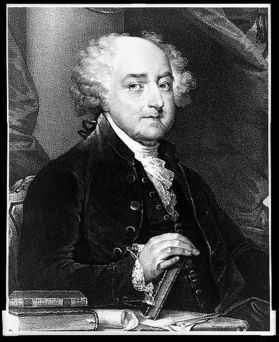John Adams: Difference between revisions
imported>Yi Zhe Wu |
imported>Yi Zhe Wu |
||
| Line 26: | Line 26: | ||
==Presidency== | ==Presidency== | ||
The Adams administration was not a tranquil one. The United States fought against France on the sea during the Quasi War. The French Directory refused to meet with American envoys and suspended commercial relations. In 1798, the French demanded American | The Adams administration was not a tranquil one. The United States fought against France on the sea during the Quasi War. The French [[Directory]] refused to meet with American envoys and suspended commercial relations. In 1798, the French demanded American [[diplomat]]s to pay [[bribe]]s in order to see the French Foreign Minister Talleyrand, which the diplomats rejected. This incident was known as the XYZ affair. [[Nationalism|Nationalist]] sentiment soon became overwhelming in the United States, causing the Congress to authorize more naval troops.<ref name="wh" /> Adams also reluctantly signed the Alien and Sedition Act as a [[war]]time measure. | ||
In 1799, however, his friendly response to French peace overture angered hardline Federalists such as [[Alexander Hamilton]], leading to an intraparty chasm. Hamilton attacked Adams for his "ungovernable indiscretion" and "distempered jealousy".<ref name="sah" /> | In 1799, however, his friendly response to French peace overture angered hardline Federalists such as [[Alexander Hamilton]], leading to an intraparty chasm. Hamilton attacked Adams for his "ungovernable indiscretion" and "distempered jealousy".<ref name="sah" /> | ||
Revision as of 20:17, 5 September 2007
John Adams (1735-1826) was an American Founding Father and President 1797-1801. He began the Adams political family based in Massachusetts. Adams was a political leader of the American Revolution and one of the drafters of Declaration of Independence. He wrote the Massachusetts Constitution of 1780, negotiated peace with Britain in 1783, became the first American minister to Britain, and was elected as the first Vice President of the United States under President George Washington 1789 to 1797.
In the presidential election of 1796, Adams, on the ticket of the Federalist Party, defeated the Democratic-Republican nominee Thomas Jefferson and became the second President of the United States. He served until 1801, after he lost to Jefferson in a rematch. His presidency was marked by the quasi-war between the United States and France, the XYZ Affair, the founding of the U.S. Navy, the passage of Aliens and Sedition Acts, peace with France, and the appointment of John Marshall as Chief Justice.
He was a cousin of another revolutionary Samuel Adams, and father of the sixth U.S. president John Quincy Adams.
Early life
John Adams was born in Braintree, Massachusetts on October 19, 1735. He was educated at Harvard College and graduated in 1755. He then studied law, was admitted to the bar in 1758, and practiced law in Suffolk County. In 1961, when his father died, Adams inherited the family farm and became a "freeholder", which enabled him to participate in the local political process. In those years he was influenced by James Otis, and adopted some of the Patriot thoughts, but he focused mainly on local politics until 1765 with the passage of Stamp Act, which he opposed vigorously.[1]
Revolutionary activities
Adams stood against Stamp Act passed by the British Parliament and joined the Sons of Liberty. He participated in the Massachusetts General Court's response to the Act. However, after the Boston Massacre of 1770, Adams served in defense of the British soldiers who conducted the shootings and six of them were acquitted as result.[2] He was a delegate in both the First and the Second Continental Congresses. He also helped the drafting, and was a signer of the Declaration of Independence. During the Revolutionary War, he went to France and Holland as a diplomat and helped negotiate the peace treaty.
Thomas Jefferson later remarked that Adams was the Declaration of Independence's "pillar of support on the floor of Congress, its ablest advocate and defender."[1]
Vice President
Adams as the vice president did not exert much executive power due to constitutional limits and his own reluctance to wield authority. His relationship with the president was friendly but distant since Washington mainly sought advices from his cabinet.[1] Adams once complained to his wife, Abigail, "My country has in its wisdom contrived for me the most insignificant office that ever the invention of man contrived or his imagination conceived".[3]
However, serving as the President of the Senate, he casted 29 tie-breaking votes, a record that has yet to be broken by his successors. These votes included ones on very important issues such as preventing a war between U.S. and Great Britain.
Presidency
The Adams administration was not a tranquil one. The United States fought against France on the sea during the Quasi War. The French Directory refused to meet with American envoys and suspended commercial relations. In 1798, the French demanded American diplomats to pay bribes in order to see the French Foreign Minister Talleyrand, which the diplomats rejected. This incident was known as the XYZ affair. Nationalist sentiment soon became overwhelming in the United States, causing the Congress to authorize more naval troops.[3] Adams also reluctantly signed the Alien and Sedition Act as a wartime measure.
In 1799, however, his friendly response to French peace overture angered hardline Federalists such as Alexander Hamilton, leading to an intraparty chasm. Hamilton attacked Adams for his "ungovernable indiscretion" and "distempered jealousy".[1]
Supreme Court appointments
John Adams appointed three justices to the Supreme Court. They are Bushrod Washington, who was George Washington's nephew, Alfred Moore, and Chief Justice John Marshall, who was instrumental in initiating the process of judicial review.
Later life and legacy
Adams largely retired from politics after stepping down from the White House. In 1820, however, he served as a delegate to the constitutional convention of Massachusetts. He resided in Quincy, Massachusetts in his later life and died there on July 4, 1826.
The naval ship USS John Adams SSBN620 was named after John Adams.
